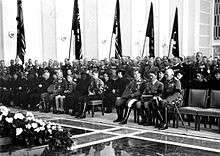Walther Wever (pilot)
| Walther Wever | |
|---|---|
 Walther Wever | |
| Born |
16 January 1923 München |
| Died |
10 April 1945 (aged 22) Near Neuruppin |
| Allegiance |
|
| Service/branch |
|
| Years of service | 1943–45 |
| Rank | Oberleutnant |
| Unit | JG 51, JG 7 |
| Awards |
Ehrenpokal der Luftwaffe German Cross in Gold Knight's Cross of the Iron Cross |
| Relations | Walther Wever (father) |
Walther Wever (16 January 1923 – 10 April 1945) was a German Luftwaffe flying ace during the Second World War. The son of former Chief of the Luftwaffe General Walther Wever, Wever served during 1943 on the Eastern Front and from 19 June 1943 until 10 April 1945 he claimed 44 aerial victories in 250 combat missions.[1] He was also a recipient of the Knight's Cross of the Iron Cross.
Career

Wever was born on 16 January 1923 in Munich in the Weimar Republic. Following flight training in mid-1943 he was posted to 3. Staffel (3rd squadron) of Jagdgeschwader 51 (JG 51—51st Fighter Wing).[Note 1] stationed on the Eastern Front. Notable landmarks during his career included his 10th kill on 1 September 1943 followed four days later by shooting down three Il-2 Sturmoviks in five minutes. On 29 March 1944 he claimed a further five aerial victories, then on 24 June he shot down his 40th opponent, and on 10 July Wever lost a foot after being himself shot down by Soviet forces on the ground. Nevertheless, Wever continued to fly and was awarded the Knight's Cross of the Iron Cross (Ritterkreuz des Eisernen Kreuzes) on 28 January 1945 for reaching the final total of 44 victories. He was then transferred to a new combat group and received further training on the Messerschmitt Me 262 jet fighter. On 10 April 1945, having not scored another kill, Wever was shot down and killed in action by Allied fighters near Neuruppin.[1]
Awards and decorations
- Iron Cross (1939) 2nd and 1st Class
- Ehrenpokal der Luftwaffe (20 March 1944)[2]
- German Cross in Gold on 20 March 1944 as Leutnant in the I./Jagdgeschwader 51[3]
- Knight's Cross of the Iron Cross on 28 January 1945 as Leutnant and pilot in the 3./Jagdgeschwader 51 "Mölders"[4][5]
Notes
- ↑ For an explanation of Luftwaffe unit designations see Organization of the Luftwaffe during World War II.
References
Citations
Bibliography
- Fellgiebel, Walther-Peer (2000) [1986]. Die Träger des Ritterkreuzes des Eisernen Kreuzes 1939–1945 — Die Inhaber der höchsten Auszeichnung des Zweiten Weltkrieges aller Wehrmachtteile [The Bearers of the Knight's Cross of the Iron Cross 1939–1945 — The Owners of the Highest Award of the Second World War of all Wehrmacht Branches] (in German). Friedberg, Germany: Podzun-Pallas. ISBN 978-3-7909-0284-6.
- Obermaier, Ernst (1989). Die Ritterkreuzträger der Luftwaffe Jagdflieger 1939 – 1945 [The Knight's Cross Bearers of the Luftwaffe Fighter Force 1939 – 1945] (in German). Mainz, Germany: Verlag Dieter Hoffmann. ISBN 978-3-87341-065-7.
- Patzwall, Klaus D.; Scherzer, Veit (2001). Das Deutsche Kreuz 1941 – 1945 Geschichte und Inhaber Band II [The German Cross 1941 – 1945 History and Recipients Volume 2] (in German). Norderstedt, Germany: Verlag Klaus D. Patzwall. ISBN 978-3-931533-45-8.
- Scherzer, Veit (2007). Die Ritterkreuzträger 1939–1945 Die Inhaber des Ritterkreuzes des Eisernen Kreuzes 1939 von Heer, Luftwaffe, Kriegsmarine, Waffen-SS, Volkssturm sowie mit Deutschland verbündeter Streitkräfte nach den Unterlagen des Bundesarchives [The Knight's Cross Bearers 1939–1945 The Holders of the Knight's Cross of the Iron Cross 1939 by Army, Air Force, Navy, Waffen-SS, Volkssturm and Allied Forces with Germany According to the Documents of the Federal Archives] (in German). Jena, Germany: Scherzers Militaer-Verlag. ISBN 978-3-938845-17-2.